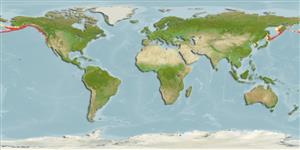>
Pleuronectiformes (Flatfishes) >
Pleuronectidae (Righteye flounders) > Pleuronectinae
Etymology: Isopsetta: Greek, isos = equal + Greek, psetta, grouper.
Environment: milieu / climate zone / depth range / distribution range
Écologie
marin démersal; océanodrome (Ref. 51243); profondeur 20 - 425 m (Ref. 6793). Temperate; 66°N - 32°N
Eastern Pacific: Bristol Bay in the southeastern Bering Sea and Amchitka Island (Aleutian Islands) to Ventura, California, USA.
Length at first maturity / Taille / Poids / Âge
Maturity: Lm 21.0 range ? - ? cm
Max length : 55.0 cm TL mâle / non sexé; (Ref. 2850); âge max. reporté: 11 années (Ref. 6885)
Description synthétique
Morphologie | Morphométrie
Épines dorsales (Total): 0; Rayons mous dorsaux (Total): 78-92; Épines anales 0; Rayons mous anaux: 58 - 69; Vertèbres: 39 - 42. Dorsal origin above eye. Caudal rounded. Pectoral small, bluntly pointed.
Common in shallow water on soft, silty bottom. Moves into shallow water in summer and to deeper water in winter (Ref. 6885). Spawning adults exhibit north-south migrations (Ref. 6885). Feeds on chaetopod marine worms, young herring, shrimps, and sand dollars (Ref. 6885). A tasty food fish, sometimes marketed (Ref. 2850). Also used for mink food (Ref. 2850).
Vinnikov, K.A., R.C. Thomson and T.A. Munroe, 2018. Revised classification of the righteye flounders (Teleostei: Pleuronectidae) based on multilocus phylogeny with complete taxon sampling. Molecular phylogenetics and evolution, 125:147-162. (Ref. 122998)
Statut dans la liste rouge de l'IUCN (Ref. 130435)
Menace pour l'homme
Harmless
Utilisations par l'homme
Pêcheries: intérêt commercial mineur; pêche sportive: oui
Plus d'informations
RéférencesAquacultureProfil d'aquacultureSouchesGénétiqueElectrophoresesHéritabilitéPathologiesTraitementNutrientsMass conversion
Outils
Articles particuliers
Télécharger en XML
Sources Internet
Estimates based on models
Preferred temperature (Ref.
123201): 1.1 - 7.6, mean 4.7 °C (based on 300 cells).
Phylogenetic diversity index (Ref.
82804): PD
50 = 1.0000 [Uniqueness, from 0.5 = low to 2.0 = high].
Bayesian length-weight: a=0.00912 (0.00457 - 0.01819), b=3.10 (2.93 - 3.27), in cm total length, based on LWR estimates for this (Sub)family-body shape (Ref.
93245).
Niveau trophique (Ref.
69278): 3.6 ±0.54 se; based on food items.
Generation time: 4.2 ( na - na) years. Estimated as median ln(3)/K based on 2
growth studies.
Résilience (Ref.
120179): Milieu, temps minimum de doublement de population : 1,4 à 4,4 années (K=0.26; tmax=11; tm=2).
Fishing Vulnerability (Ref.
59153): Low to moderate vulnerability (35 of 100).
Nutrients (Ref.
124155): Calcium = 35.2 [13.5, 60.7] mg/100g; Iron = 0.281 [0.139, 0.548] mg/100g; Protein = 18.1 [15.6, 20.1] %; Omega3 = 0.367 [0.180, 0.767] g/100g; Selenium = 20.8 [10.7, 45.2] μg/100g; VitaminA = 6.76 [1.59, 30.94] μg/100g; Zinc = 0.387 [0.261, 0.583] mg/100g (wet weight); based on
nutrient studies.
